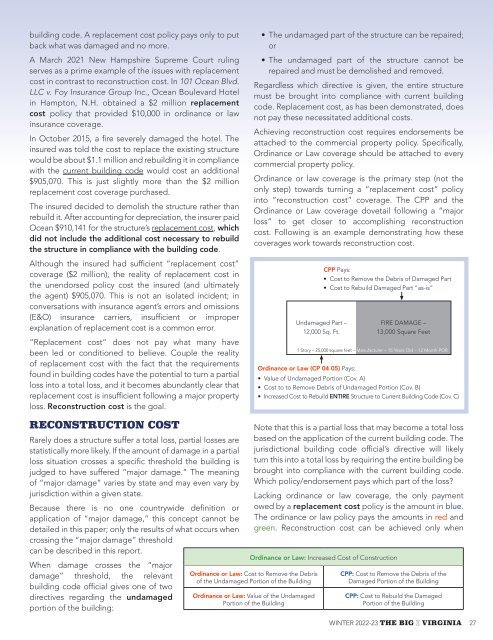The Big I Virginia Winter 2022-23
Create successful ePaper yourself
Turn your PDF publications into a flip-book with our unique Google optimized e-Paper software.
uilding code. A replacement cost policy pays only to put<br />
back what was damaged and no more.<br />
A March 2021 New Hampshire Supreme Court ruling<br />
serves as a prime example of the issues with replacement<br />
cost in contrast to reconstruction cost. In 101 Ocean Blvd.<br />
LLC v. Foy Insurance Group Inc., Ocean Boulevard Hotel<br />
in Hampton, N.H. obtained a $2 million replacement<br />
cost policy that provided $10,000 in ordinance or law<br />
insurance coverage.<br />
In October 2015, a fire severely damaged the hotel. <strong>The</strong><br />
insured was told the cost to replace the existing structure<br />
would be about $1.1 million and rebuilding it in compliance<br />
with the current building code would cost an additional<br />
$905,070. This is just slightly more than the $2 million<br />
replacement cost coverage purchased.<br />
<strong>The</strong> insured decided to demolish the structure rather than<br />
rebuild it. After accounting for depreciation, the insurer paid<br />
Ocean $910,141 for the structure’s replacement cost, which<br />
did not include the additional cost necessary to rebuild<br />
the structure in compliance with the building code.<br />
Although the insured had sufficient “replacement cost”<br />
coverage ($2 million), the reality of replacement cost in<br />
the unendorsed policy cost the insured (and ultimately<br />
the agent) $905,070. This is not an isolated incident; in<br />
conversations with insurance agent’s errors and omissions<br />
(E&O) insurance carriers, insufficient or improper<br />
explanation of replacement cost is a common error.<br />
“Replacement cost” does not pay what many have<br />
been led or conditioned to believe. Couple the reality<br />
of replacement cost with the fact that the requirements<br />
found in building codes have the potential to turn a partial<br />
loss into a total loss, and it becomes abundantly clear that<br />
replacement cost is insufficient following a major property<br />
loss. Reconstruction cost is the goal.<br />
• <strong>The</strong> undamaged part of the structure can be repaired;<br />
or<br />
• <strong>The</strong> undamaged part of the structure cannot be<br />
repaired and must be demolished and removed.<br />
Regardless which directive is given, the entire structure<br />
must be brought into compliance with current building<br />
code. Replacement cost, as has been demonstrated, does<br />
not pay these necessitated additional costs.<br />
Achieving reconstruction cost requires endorsements be<br />
attached to the commercial property policy. Specifically,<br />
Ordinance or Law coverage should be attached to every<br />
commercial property policy.<br />
Ordinance or law coverage is the primary step (not the<br />
only step) towards turning a “replacement cost” policy<br />
into “reconstruction cost” coverage. <strong>The</strong> CPP and the<br />
Ordinance or Law coverage dovetail following a “major<br />
loss” to get closer to accomplishing reconstruction<br />
cost. Following is an example demonstrating how these<br />
coverages work towards reconstruction cost.<br />
Undamaged Part –<br />
12,000 Sq. Ft.<br />
CPP Pays:<br />
• Cost to Remove the Debris of Damaged Part<br />
• Cost to Rebuild Damaged Part “as-is”<br />
FIRE DAMAGE –<br />
13,000 Square Feet<br />
1 Story – 25,000 square feet – Manufacturer – 15 Years Old – 12 Month POR<br />
Ordinance or Law (CP 04 05) Pays:<br />
• Value of Undamaged Portion (Cov. A)<br />
• Cost to to Remove Debris of Undamaged Portion (Cov. B)<br />
• Increased Cost to Rebuild ENTIRE Structure to Current Building Code (Cov. C)<br />
RECONSTRUCTION COST<br />
Rarely does a structure suffer a total loss, partial losses are<br />
statistically more likely. If the amount of damage in a partial<br />
loss situation crosses a specific threshold the building is<br />
judged to have suffered “major damage.” <strong>The</strong> meaning<br />
of “major damage” varies by state and may even vary by<br />
jurisdiction within a given state.<br />
Because there is no one countrywide definition or<br />
application of “major damage,” this concept cannot be<br />
detailed in this paper; only the results of what occurs when<br />
crossing the “major damage” threshold<br />
can be described in this report.<br />
When damage crosses the “major<br />
damage” threshold, the relevant<br />
building code official gives one of two<br />
directives regarding the undamaged<br />
portion of the building:<br />
Note that this is a partial loss that may become a total loss<br />
based on the application of the current building code. <strong>The</strong><br />
jurisdictional building code official’s directive will likely<br />
turn this into a total loss by requiring the entire building be<br />
brought into compliance with the current building code.<br />
Which policy/endorsement pays which part of the loss?<br />
Lacking ordinance or law coverage, the only payment<br />
owed by a replacement cost policy is the amount in blue.<br />
<strong>The</strong> ordinance or law policy pays the amounts in red and<br />
green. Reconstruction cost can be achieved only when<br />
Ordinance or Law: Increased Cost of Construction<br />
Ordinance or Law: Cost to Remove the Debris<br />
of the Undamaged Portion of the Building<br />
Ordinance or Law: Value of the Undamaged<br />
Portion of the Building<br />
CPP: Cost to Remove the Debris of the<br />
Damaged Portion of the Building<br />
CPP: Cost to Rebuild the Damaged<br />
Portion of the Building<br />
WINTER <strong>2022</strong>-<strong>23</strong> THE BIG I VIRGINIA 27

















